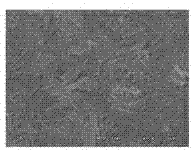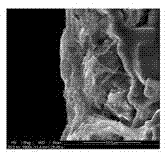Preparation method of ceramic microfiltration membrane by using attapulgite nano fibers as separating layer
A nanofiber, attapulgite technology, applied in semi-permeable membrane separation, chemical instruments and methods, membrane technology and other directions, can solve the problems of high preparation cost, difficult preparation and high cost, and achieve low price and high permeability. Throughput, the effect of reducing the preparation cost
- Summary
- Abstract
- Description
- Claims
- Application Information
AI Technical Summary
Problems solved by technology
Method used
Image
Examples
Embodiment 1
[0024] Example 1: Preparation of attapulgite / alumina microfiltration membrane
[0025] Add 0.3g of attapulgite nanofibers with a diameter of 30-40nm and a length of about 0.5-1μm into 299.07g of water and mix well, then add 0.3g of polyethyleneimine, 0.3g of methylcellulose, and 0.03g of silicone defoamer in sequence, After high-speed stirring and ultrasonic dispersion, the coating liquid was prepared; the film was coated on a tubular alumina porous support with an average pore size of 4 microns, and dried in a hot air drying oven at 70°C for 24 hours; ℃ / min to 300°C, hold for 3 hours, 2°C / min to 400°C, hold for 6 hours, and cool down naturally in the furnace to obtain the attapulgite / alumina microfiltration membrane. from figure 1 (SEM) It can be seen from the photo that the thickness of the separation layer on the support is 5 μm, the membrane pore size is 100 nm, the separation layer completely covers the transition layer, the thickness is uniform, the surface is complete...
Embodiment 2
[0026] Embodiment 2: Preparation of attapulgite / stainless steel microfiltration membrane
[0027] Add 22.65g of attapulgite nanofibers with a diameter of 40-60nm and a length of about 1-2μm into 266.385g of water and mix thoroughly, then add 2.55g of polyacrylic acid, 7.65g of carboxymethyl cellulose, and 0.765g of silicone defoamer. High-speed stirring and ultrasonic dispersion to prepare the coating liquid; coating the film on a tubular stainless steel porous carrier with an average pore size of 5 microns, drying it in a hot air drying oven at 90°C for 17 hours; Raise the temperature to 350°C, keep it warm for 1.5h, then raise the temperature to 600°C at 1°C / min and keep it warm for 3.5h, then cool down naturally in the furnace to obtain attapulgite / stainless steel microfiltration membrane. The separation layer has a thickness of 1 μm and a pore diameter of 200 nm.
Embodiment 3
[0028] Example 3: Preparation of Attapulgite / Titanium Aluminum Alloy Microfiltration Membrane
[0029] Add 45g of attapulgite nanofibers with a diameter of 60-80nm and a length of about 2-3μm into 60g of water and mix thoroughly, then add 30g of polyethylene glycol, 150g of polyvinyl alcohol, and 15g of silicone defoamer in sequence, after high-speed stirring and ultrasonic dispersion Prepare the coating solution; coat the film on a sheet-type titanium-aluminum alloy porous carrier with an average pore size of 10 microns, dry it in a hot air drying oven at 110°C for 10 hours; then raise the temperature to 400°C at 5°C / min in a high temperature furnace ℃, hold for 0.5h, raise the temperature to 800°C for 1h at 1°C / min, cool down naturally in the furnace, and obtain the attapulgite / titanium aluminum alloy microfiltration membrane. The separation layer has a thickness of 20 μm and a pore diameter of 400 nm.
PUM
| Property | Measurement | Unit |
|---|---|---|
| thickness | aaaaa | aaaaa |
| pore size | aaaaa | aaaaa |
| length | aaaaa | aaaaa |
Abstract
Description
Claims
Application Information
 Login to View More
Login to View More - R&D
- Intellectual Property
- Life Sciences
- Materials
- Tech Scout
- Unparalleled Data Quality
- Higher Quality Content
- 60% Fewer Hallucinations
Browse by: Latest US Patents, China's latest patents, Technical Efficacy Thesaurus, Application Domain, Technology Topic, Popular Technical Reports.
© 2025 PatSnap. All rights reserved.Legal|Privacy policy|Modern Slavery Act Transparency Statement|Sitemap|About US| Contact US: help@patsnap.com


